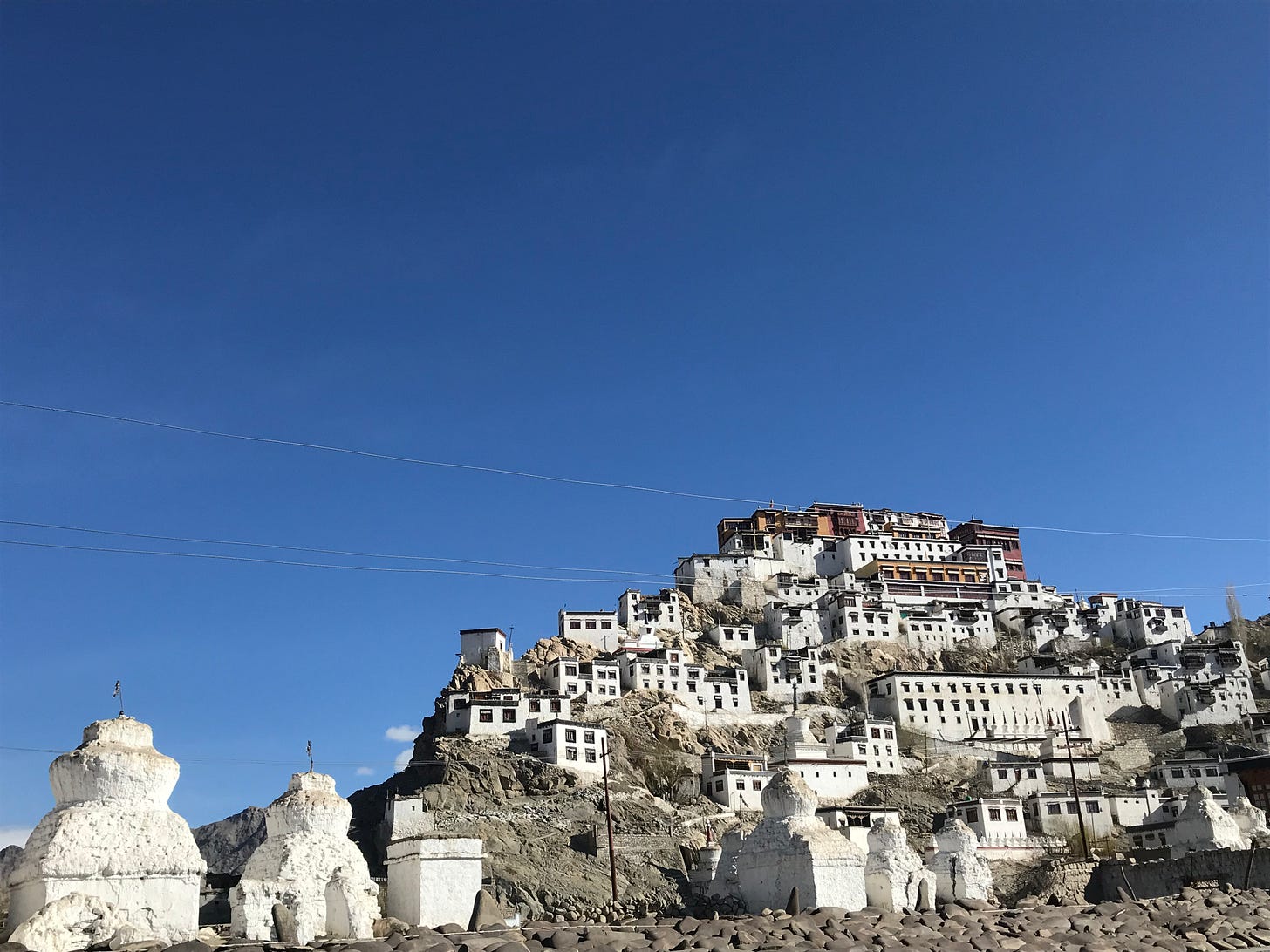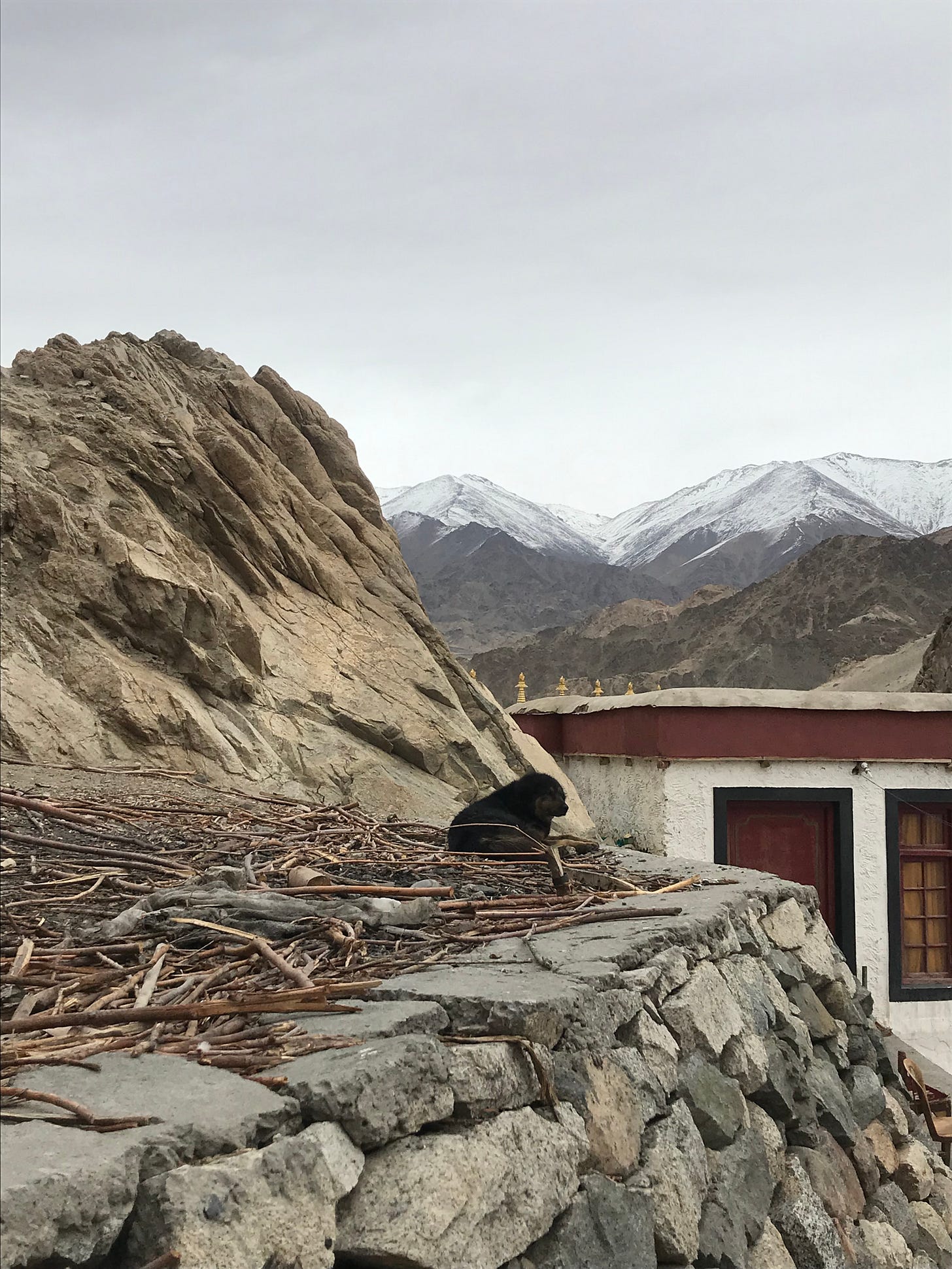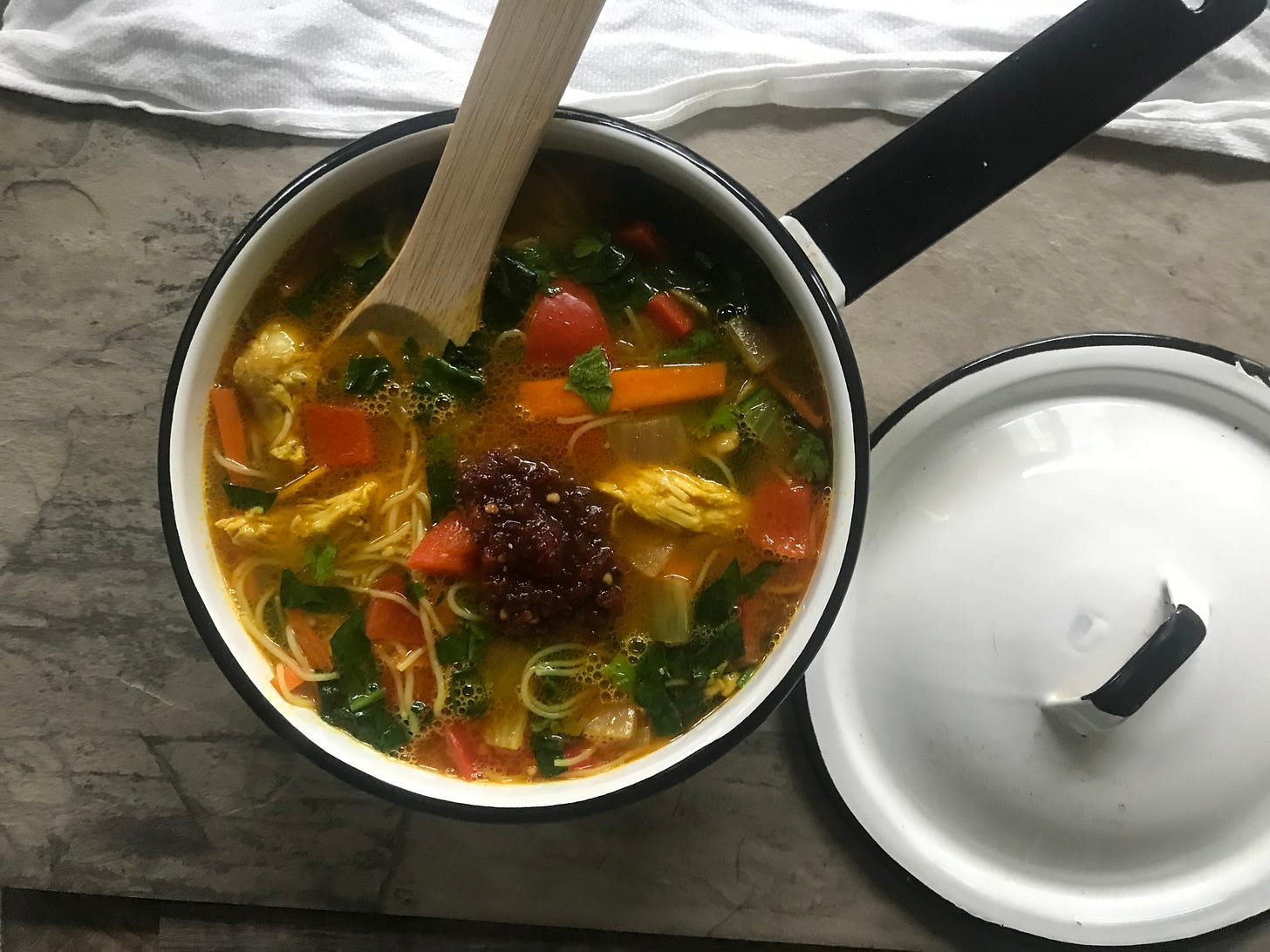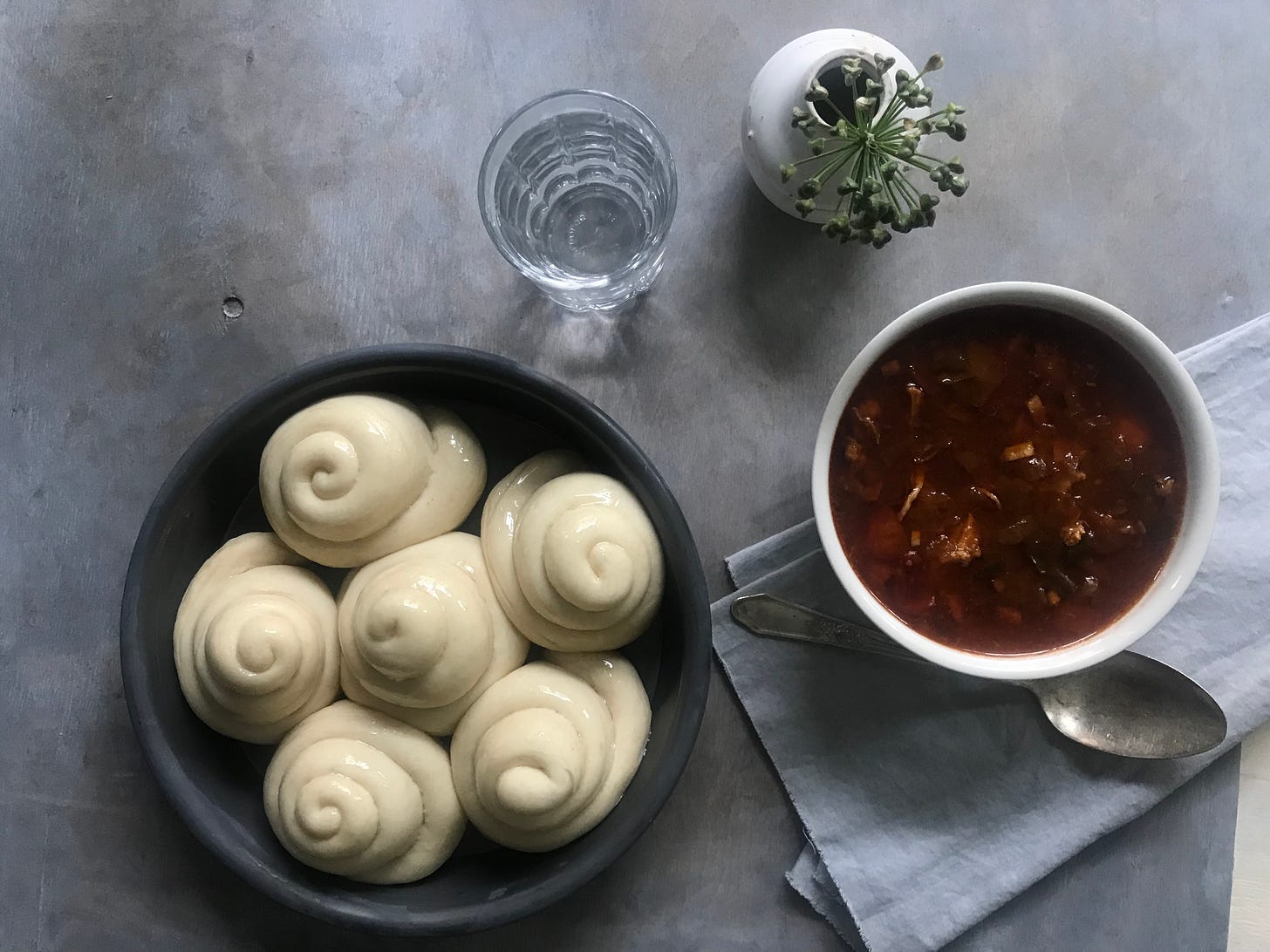2 Restorative Soup Recipes and a Fiery Hot Sauce From Tibetan Buddhist Monks in The Himalayas
Hello! Welcome to my very first newsletter. I appreciate that you’re here! I’m getting this all started with a visit to the Tibetan Buddhist monastery of Thikse in the Indian state of Ladakh, high, high, high! in the Himalayas. To reach Ladakh, you can either take a two-hour flight from Delhi or enjoy (endure?) a grueling 22-hour bus ride on a dirt road that winds through three of the highest drivable mountain passes in the world. I did this once, along with fellow travelers, countless chickens, seven goats and a driver who thought it was funny to speed up at the hairpin turns while plummeting down the mountain. I recommend the flight.
The high altitude of Ladakh can be challenging because of the anemic air that makes breathing and climbing stairs (and sometimes thinking) difficult. But this arid, remote region is a safe haven for Tibetans fleeing Chinese occupation, including the many Tibetan Buddhist monks who have found safe harbor here. Surrounded by snow-capped mountains and glaciers that never melt, the state is cut off from the rest of the world during the harsh winter months and even during the summer, mittens and a hat are definitely recommended.
I first traveled to Ladakh because I was curious about Buddhism and Tibetan cuisine and because there’s no better time than the present to spend some time in the Himalayas. I’m currently in the design phase of a book about the culinary traditions of monasteries, temples, mosques and synagogues around the world that I’ve been writing for W.W. Norton for what feels like forever (my editor would probably agree). My inspiration for the book was set in motion during my first visit to Thikse.
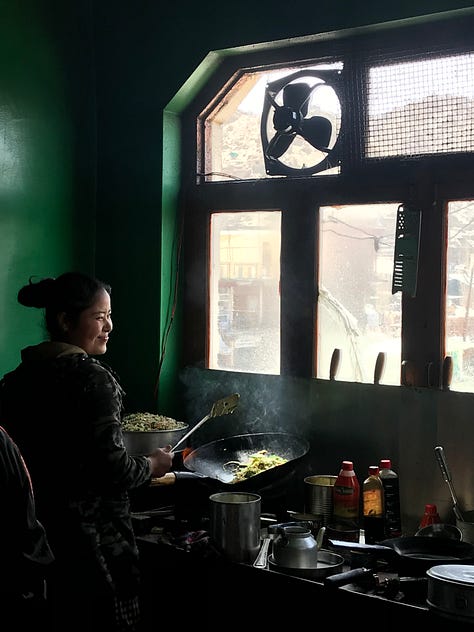
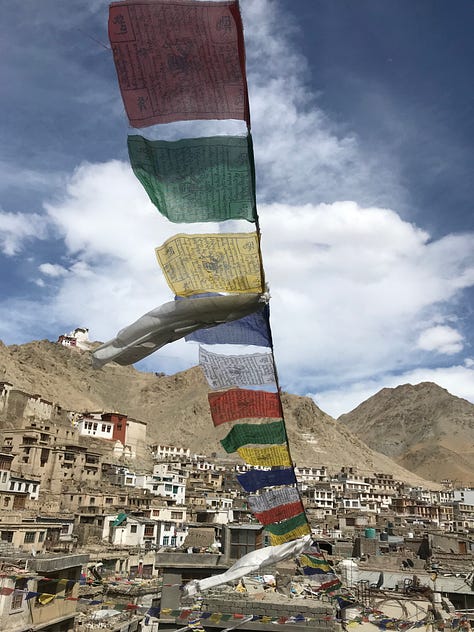
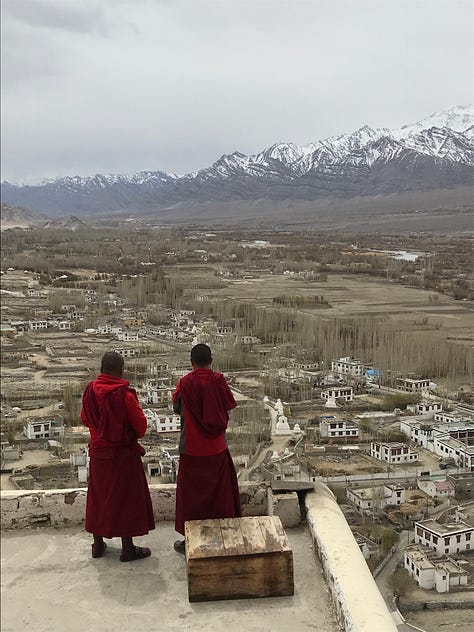
I expected to discover a solemn bunch of monks more interested in prayer and drumming ceremonies (and don’t get me wrong, there’s plenty of that too) than in keeping time with the pulse of the world. What I discovered instead were monks who wore Yankees caps, loved taking the New York City subway, wanted to talk about the latest Netflix limited series, and ate food prepared by a salty former Navy officer named Jampa who knew his way around a Pacojet.
It was refreshing and intriguing and I wondered if other monks throughout the world were as dialed-in as those at Thikse (surprise: they are!). That first visit kicked off what at times felt like an endless journey (one I serendipitously concluded just before the pandemic started). My book research came full circle when the (incredible!) photographer and I concluded our epic adventure to monasteries around the world at Thikse, the place that started it all.
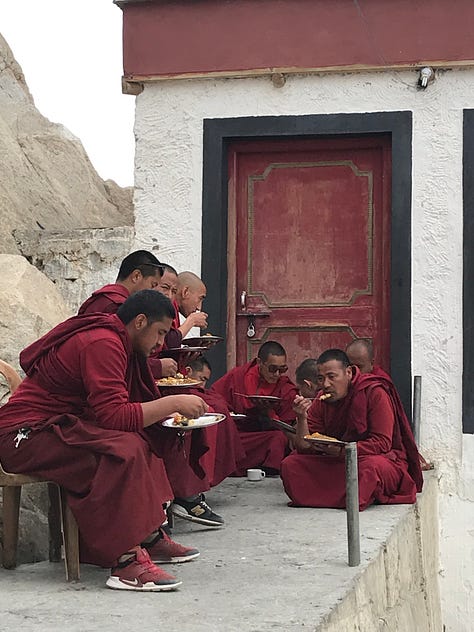
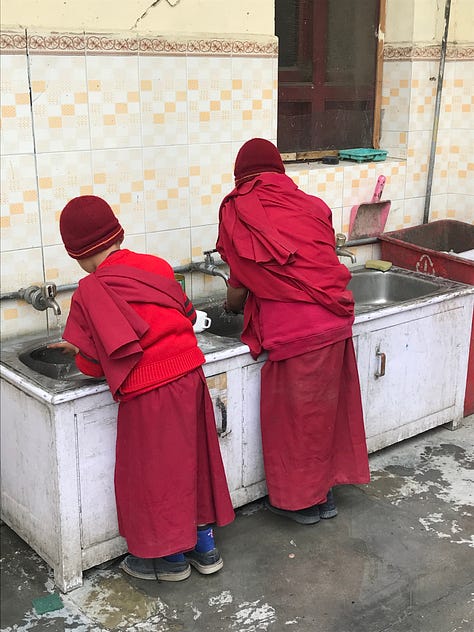
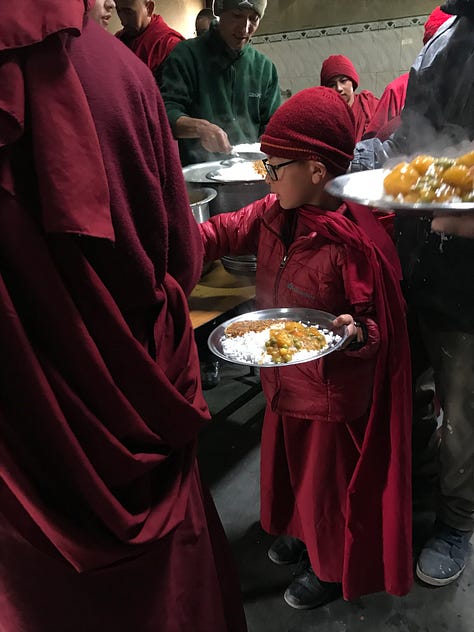
In more hospitable weather, the nearby town of Leh comes alive with activity. Buddhist monks dressed in red robes mix with locals in bustling markets selling fresh vegetables, dried apricots, walnuts, yak cheese, and aromatic foods like fermented buns called tingmo and a Tibetan chicken noodle soup called thukpa. The reassuring hum of prayer wheels spinning buzzes throughout the town, sending the Ladakhi people's hopes and wishes up to the mountaintops.
Before my first visit where I hoped to cook with the monks, I tried to connect with locals, but the lack of internet access in this far-flung region made it impossible. It wasn't until I arrived and asked a monk in the marketplace for advice that I learned about Thikse. The next morning, I encountered that same monk as I ascended (and wheezed) my way up the steep stairs to Thikse. He gingerly directed me to the kitchen before continuing down the stairs, his scarlet robe fluttering in the thin dry wind.
Encountering him again seemed like a good sign, but my hopes were dashed when a teenage monk at the kitchen door informed that I couldn't cook at Thikse that day. I was about to leave when Jampa the chef called me back. He had salt and pepper hair and wore black sunglasses and a silky cobalt blue Members Only jacket. He explained that cooking was already finished for the day, but invited me to return the next morning. When I asked what time I should arrive, he shrugged and replied nonchalantly, "When the sun first appears on the horizon."
The next morning we drank steamy hot yak butter tea at sunrise, the sun’s pink and gold rays splitting the dusk sky into silver shards and then I dove into the rest of the day’s rituals. They included a hypnotic drumming session punctuated by handfuls of tsampa, barley flour and yak butter tea mixed into a shaggy dough. I helped Jampa prepare lunch even though his nimble mise en place prep put me to shame. His years of cooking at sea for a ship full of ravenous soldiers were evident in his deft knife skills; he made fast work of the daikon, cabbage, carrots, onions, garlic, and potatoes in front of him.
After lunch was ready, the kitchen filled with dozens of monks of all ages who noisily served themselves on tin plates from the buffet of Tibetan delicacies. They ate outside under the clear blue Himalayan sky. The younger monks played with wooden swords after finishing their meal, scooping their leftovers into a dog dish shared by Thikse's three resident canines.
I asked a monk named Tashi about the dogs. He was in his mid-twenties and spent the morning telling me about his recent trip to New York, where he ate a knish and went to the top of Rockefeller Center. He explained, "We did not adopt them. They adopted us. Each one arrived by walking up the mountain to Thikse's door. You cannot turn away a living being in need, and they made the decision to honor us by living out their lives here. They are wise, good-natured dogs who found peace here at Thikse."
The true miracle is not walking on water or walking in air, but simply walking on this earth.
― Thich Nhat Hanh
Thukpa (Tibetan Chicken Noodle Soup)
Serves 4
Preparation time: 1 hour and 15 minutes
On chilly spring days (and let’s face it, basically every day at Thikse is chilly!), there's nothing quite like a steaming bowl of thukpa, a Tibetan noodle soup that warms the body and restores the spirit. This hearty soup is particularly essential in Ladakh, where temperatures can plummet to forty below Fahrenheit in the winter, but remain frigid even in the heart of summer. Originally from eastern Tibet, thukpa typically features hand-pulled noodles served with beef, mutton, or yak. This recipe uses chicken but feel free to substitute it with tofu or tempeh and vegetable stock for a vegetarian version. It has been simplified for busy days by substituting homemade noodles with store-bought egg noodles but any preferred Asian noodle such as ramen or soba would work. Whether you're feeling under the weather or just enjoying a cozy springtime day, thukpa is the perfect comfort food. It’s easy to prepare and a fun and unexpected substitute for standard chicken noodle soup.
5 cups water
2 cups chicken stock
1 chicken breast, with its bone and skin
1 chicken thigh, with its bone and skin
2 chicken legs, with their bones and skin
1 large white onion, coarsely chopped
1 large carrot, peeled and coarsely chopped
1 celery rib, coarsely chopped
1-inch segment ginger, peeled and finely chopped
4 garlic cloves, peeled and finely chopped
1 Thai chile, seeded and finely chopped
1 tablespoon soy sauce
Juice of 1 lime
1 small daikon radish, thinly sliced
8 ounces egg noodles
Salt and pepper to taste
Scallions, for garnish
Sour cream and sepen (optional), for garnish
In a large pot, bring three cups of water and the stock to a boil. Add the chicken, onion, carrot, celery, ginger, garlic, chili and soy sauce. Return to a boil then reduce the heat to a low simmer, cover and cook for 45 minutes. Carefully remove the chicken from the pot using tongs or a slotted spoon. Add the remaining water, lime juice, radish and noodles to the pot and gently simmer uncovered until the noodles are cooked through, between seven to nine minutes. Season with salt and pepper. Once the chicken is cool enough to handle, remove the meat from the bones, break it up into bite-sized pieces, coarsely chop the skin and return the meat and skin to the soup. Ladle piping hot soup into individual bowls. Garnish with scallions and a dollop of sour cream and a generous spoonful of sepen (if you’re craving a little heat).
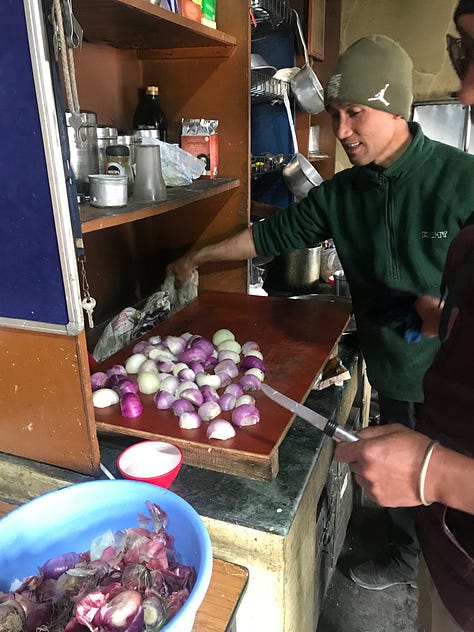
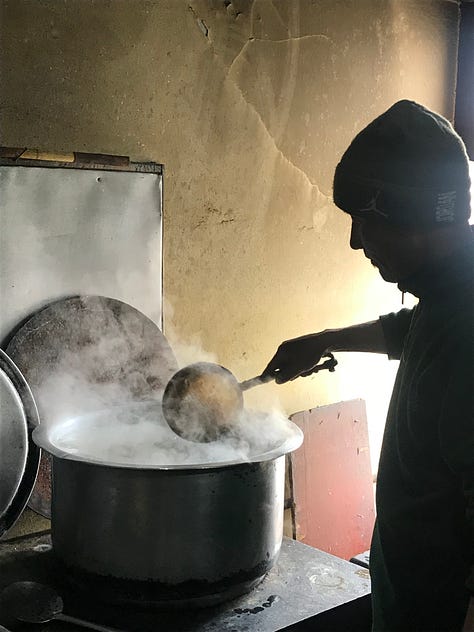

Sepen
Makes about 1 cup
Preparation time: 10 minutes
At Thikse and throughout Leh, fiery condiments are always in abundance, especially when momos, skyu, or thukpa are served. Virtually every household, restaurant, and monastery in Ladakh has its own unique variation of this spicy accompaniment, and Thikse is no exception. Sepen is a staple at every meal, delivering a burst of fiery flavor in even the smallest spoonful. Of course, if you prefer a milder taste, you can always reduce the amount of chiles used in the recipe. But for an extra kick, you can also opt to include Szechuan peppercorns, which add an electrifying sensation that livens it up. Sepen will keep in a covered container in the refrigerator for up to two weeks, its flavor and heat intensifying with each passing day.
1 small white onion, coarsely chopped
3 garlic cloves
1 tablespoon finely chopped ginger
2 teaspoons cumin powder, roasted
1 teaspoon turmeric
1/4 teaspoon Szechuan peppercorns, optional
Pinch asafoetida (optional)
3 long red chiles such as Kashmiri red chiles, coarsely chopped
2 roma tomatoes, coarsely chopped
Salt, to taste
In the bowl of a food processor, place the onion, garlic, ginger, chiles, cumin, turmeric, Szechuan peppercorns and asafoetida and pulse until just incorporated. Add the tomatoes and process on low speed until blended. Season with salt. To make the spice paste, combine all the ingredients, except the tomatoes, in a blender or food processor and process until finely chopped. Add the tomatoes and process until combined.
Yak Butter Tea
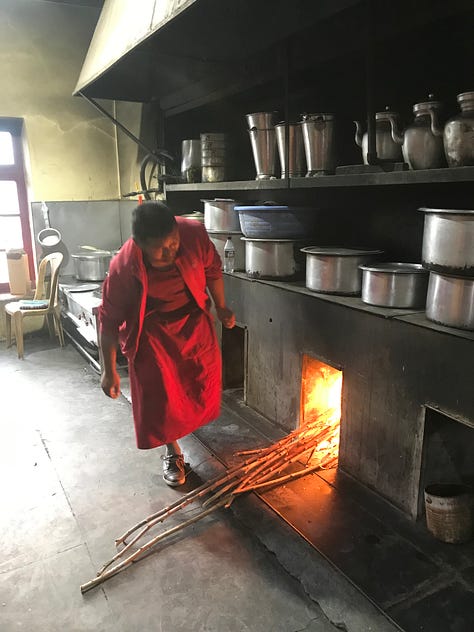
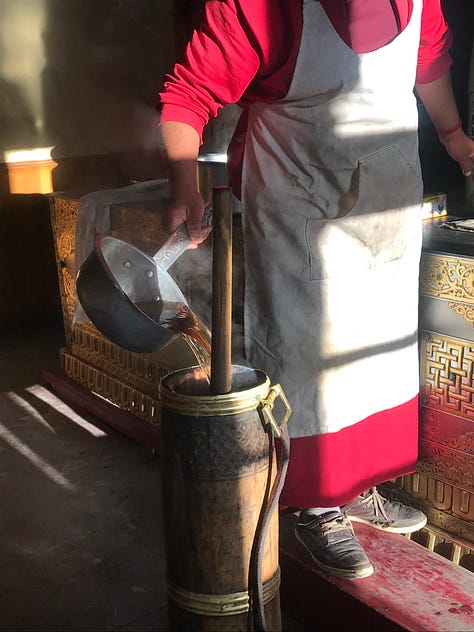
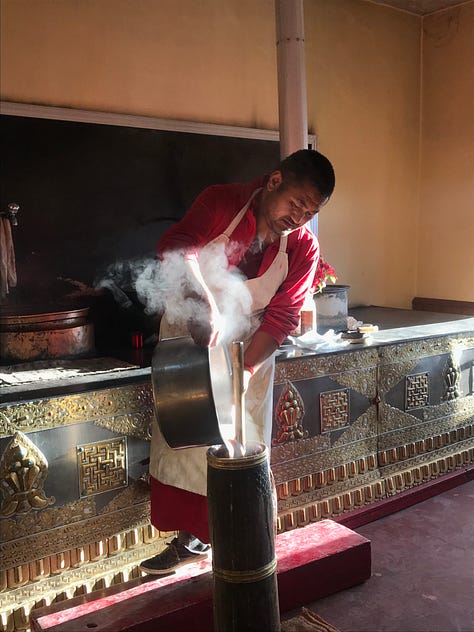
Yak butter tea is a treasured beverage for Tibetans, especially the monks at Thikse who enjoy it for its unique flavor, texture, and nourishing properties. The nutty and salty-sweet taste, coupled with its thick and creamy consistency, makes it a delightful comfort. It also provides a daily dose of the essential calories, fat, and energy needed to thrive at high altitudes. The ingredients are also believed to improve blood circulation, enhance muscle strength, and promote the production of regenerative fluids, all of which are crucial for those living in the Himalayas.
While yak butter tea is sometimes associated with affluence, the monks of Thikse are fortunate enough to have access to it year-round. They brew a rich and slightly bitter black tea, pu’erh, and mix it with toasted barley flour, milk curds, and softened yak butter, creating a perfect balance of flavors. It’s served each morning at their drumming ceremony, punctuating a deeply spiritual practice with warm, enveloping comfort. For the monks of Thikse, yak butter tea is not only a drink, but a source of symbiotic balance between the mind and body. It fuels them through their daily activities, from cooking and farming to prayer and meditation.
My newsletter is reader-supported.
Free subscribers get limited access to the weekly newsletter and two weeks worth of archives.
Paid subscribers get complete access to all of the content in my newsletters and my entire archives. You’ll also get all of the recipes, guides, interviews, cooking tips, essays and more, plus the ability to comment and participate in discussions.
Newsletters will arrive right in your Inbox or you can read them through the app.
Let’s Talk!
Please join the What’s Good Here community by posting a comment or to just say hello to get the conversation started!
(for paid subscribers only)
Image attributions throughout the newsletter are mine unless otherwise noted.
I have a lot more content for paid subscribers including two recipes, one for the Tibetan sweet and sour soup called shapta and one for the light and airy fermented buns called tingmo (which are perfect for dipping into shapta and oh-so-shiny-and- pretty - check out the photo below)! There’s also a section on flour milling with tips on how to do it at home to really impress at your next pizza party!
If you would like to learn more about me, hear more about my goals for What’s Good Here, and discover what I will deliver to you each week through this newsletter, you can find that information here or check out my Instagram or website.




